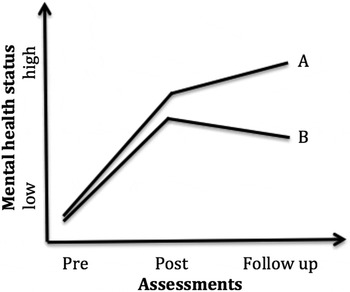Over the past 100 years, claims that specific psychotherapeutic orientations produce more sustainable outcomes, when compared with other orientations or interventions common across psychotherapies, have been pervasive and influential. This kind of differences in relative efficacy over follow-up time periods is referred to as the ‘sleeper effect’, i.e., the effects of psychotherapy A against psychotherapy B produces larger treatment differences at follow-up than at post-assessment (see Fig. 1).

Fig. 1. Example of the sleeper effect: More sustainable outcomes at follow-up in favour of psychotherapy A in comparison with psychotherapy B.
Background
Psychotherapeutic treatments conducted by trained professionals that are intended to be therapeutic (i.e., bona fide psychotherapy) are shown to be highly effective for treating many mental health conditions. Interestingly, there are marginal to small differences in efficacy between the various bona fide psychotherapy orientations (e.g., cognitive behavioural therapy v. Psychodynamic therapy) at post-treatment, so attention has turned towards examining any potential sleeper effects that might favour one treatment over another. The sleeper effect has been formulated in the following ways:
-
• The depth psychodynamic therapies: Lasting structural personality changes will only be achieved by a profound look into the depths of the mind. In comparison with more behaviourally oriented treatments, insight-oriented psychodynamic therapies work through the subconscious and therefore the effects are more sustainable (Shedler, Reference Shedler2010).
-
• The carefully controlled evidence-based (mostly cognitive-behavioural) therapies: Disorder-specific evidence-based therapies with close adherence to treatment manuals/guidelines under randomised controlled study conditions have been carefully developed and tested. Therefore, their effects will be more sustainable in comparison with less controlled treatments (Tolin, Reference Tolin2010).
-
• The specificity of additive component designs: Additive intervention components address specific therapeutic aspects, which may result in broader patient competencies and more sustainable treatment effects in comparison with treatments with less systematic focus on the specific ingredient (Bell et al. Reference Bell, Marcus and Goodlad2013).
Empirical evidence
To test the presence of the sleeper effect, the statistical results of randomised controlled psychotherapy trials should indicate a treatment (psychotherapy A v. B) by time (post v. follow-up) interaction. In parallel, longitudinal meta-analyses can test these treatment by time interactions in direct treatment comparisons.
We searched the term ‘longitudinal meta-analysis’ and ‘psychotherapy’ and ‘follow-up’ in PsycINFO and MEDLINE (September 30, 2016) and found 18 hits from which three meta-analyses of the direct treatment comparisons provided a statistical test of the sleeper effect (Flückiger et al. Reference Flückiger, Del Re, Munder, Heer and Wampold2014, Reference Flückiger, Del Re and Wampold2015; Kivlighan et al. Reference Kivlighan, Goldberg, Abbas, Pace, Yulish, Thomas, Cullen, Flückiger and Wampold2015). In addition, one longitudinal meta-analysis tested the longitudinal course within a treatment (Hanrahan et al. Reference Hanrahan, Field, Jones and Davey2013):
-
• Psychodynamic v. non-dynamic psychotherapies (k = 20 primary studies): Findings indicated equivalent efficacy at post-treatment and at follow-up, no sleeper effect (Kivlighan et al. Reference Kivlighan, Goldberg, Abbas, Pace, Yulish, Thomas, Cullen, Flückiger and Wampold2015).
-
• Evidence-based psychotherapy v. treatment as usual (k = 15): Small-to-moderate differences in efficacy were found in favour of evidence-based treatments at post-treatment but no extended efficacy at follow-up. The treatment as usual conditions ranged from the absence of minimal mental health treatment to legitimate psychological interventions provided by trained professionals, the latter of which indicated small differences in relative efficacy at post-treatment as well as at follow-up, no sleeper effect (Wampold et al. Reference Wampold, Budge, Laska, Del Re, Baardseth, Flückiger, Minami, Kivlighan and Gunn2011; Flückiger et al. Reference Flückiger, Del Re, Munder, Heer and Wampold2014).
-
• Additive components v. usual components (k = 30): A re-analysis of Bell et al. – meta analysis (2013) found marginal to small differences in efficacy at post-treatment and no extended efficacy at follow-up in favour of additive components (Flückiger et al. Reference Flückiger, Del Re and Wampold2015). In parallel, the longitudinal course in cognitive-behavioural therapy in generalised anxiety was tested and marginal differences in efficacy were found at post-treatment in favour to treatments with additive components. However, no extended efficacy at follow-up was found, no sleeper effect (k = 17, Hanrahan et al. Reference Hanrahan, Field, Jones and Davey2013).
Conclusions
Historically, the argument that some psychotherapy orientations produced more sustainable outcomes at follow-up than others contributed to the split of the psychotherapy community into different camps. The most up-to-date meta-analytic evidence indicates a surprisingly different, yet consistent picture: There is marginal empirical evidence for the presence of a sleeper effect in comparative psychotherapy research. None of the meta-analyses found a growth of relative efficacy at follow-up assessment. While the theoretical arguments for differences in efficacy (depth, carefully controlled, specificity) are reasonable, there is little theoretical reason for why these effects would only notably appear at follow-up assessment points. Clearly, there is variation in the sustainability. However, the attribution of such an effect to a single psychotherapy orientation is not justified based on the evidence. Methodologically, potential confounds such as dropout rates, external events over time and additional treatments may have made it difficult to detect differences in relative efficacy at follow-up (Knekt et al. Reference Knekt, Lindfors, Härkänen, Välikoski, Virtala, Laaksonen and Virtala2008; Durham et al. Reference Durham, Higgins, Chambers, Swan and Dow2012).
Nevertheless, the sleeper effect as a lasting theoretical claim has survived over the past 100 years. The sleeper effect might be thought of as a strategic effect in the sense that the dominant and most powerful orientations in this time (earlier psychodynamic therapies, now maybe evidence-based psychotherapies) are ‘pulled’ to claim sustainability of their own approach; maybe in the hope of further decades of data collection to get an empirical proof of the claim.
Financial support
None.
Conflict of interest
None.



